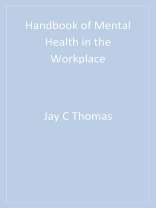Organizations need to contend with issues related to disruptive psychopathological behavior that in years past may have been swept under the rug. Also, clinicians are more aware that their clients′ mental health concerns are influenced by the workplace and that treatment without regard to what happens at work is not apt to be successful.
The Handbook of Mental Health in the Workplace explores how psychological disorders impact the ability to work and recommends treatments and their likely side effects. It is designed to give the mental health clinician, I/O psychologist, and human resources manager the information they need to determine the employee′s fitness for work and what, if any, accommodations may be needed.
The handbook is divided into five parts:
Part I: General Issues
Presents an overview of the field and outlines the legal rights and responsibilities for employees and employers.
Part II: Working Conditions, Life Stressors, and Mental Health
Presents the current research on job stress and its effects on mental health, the effects of work-family conflicts, women′s health issues, and organizational interventions for reducing stress and conflict.
Part III: Effects of Psychopathology on Work
Provides detailed descriptions of the most common forms of psychopathology that may affect the workplace.
Part IV: Effects of Disruptive Behavior at Work
Explores behavior that may not relate to standard diagnostic categories but has clear mental health implications. This includes anger and violence, poor social skills, the effects of abuse, exposure to traumatic events, passive-aggressive behavior, and grieving.
Part V: Organizational Practice and Mental Health
Presents the mental health considerations for designing organizational policy, job analysis, and accommodations for the disabled.
This handbook should prove beneficial to human resources professionals, mental health practitioners, I/O psychologists, and administrators of employee assistance programs (EAPs). Graduate students and professors in psychology and management will also find this a valuable reference.
Daftar Isi
Preface
Part I: GENERAL ISSUES
1. Mental Health in the Workplace: Toward an Integration of Organizational & Clinical Theory, Research, & Practice – Jay C. Thomas; Jeffrey Hite
2. Mental Health & Disabilities, the Employer, & the Law – H. John Bernardin & Barbara A. Lee
Part II: WORKING CONDITIONS, LIFE STRESSORS, & MENTAL HEALTH
3. Models of Job Stress – Valerie J. Sutherland & Cary L. Cooper
4. Effects of Job Stress on Mental & Physical Health – Carlla S. Smith, Lorne M. Sulsky, & Krista L. Uggeslav
5. The Unbalanced Life: Work & Family Conflict – Leslie B. Hammer, Cari L. Colton, Suzanne Caubet, & Krista J. Brockwood
6. Organizationally Targeted Interventions Aimed at Reducing Workplace Stress – Terry A. Beehr & Michael P. O′Driscoll
PART III: EFFECTS OF PSYCHOPATHOLOGY ON WORK
7. Major Depression – Paula Truax & Tracy Mc Donald
8. Bi-Polar Disorder – Edward S. Friedman; Andrea Fagiolini; Michael E. Thase
9. Generalized Anxiety Disorder – Erin L. Scott, David M. Fresco, & Richard G. Heimberg
10. Social Anxiety Disorder, Specific Phobias, & Panic Disorder – Scott F. Coffey, Brian P. Marx, & Deborah A. Roth
11. Post-Traumatic Stress Disorder (PTSD) – Walter Penk, Charles Drebing, & Russell Schutt
12. Schizophrenia – Kim T. Mueser & Deborah R. Becker
13. Anti-Social Personality Disorder – Brian P. O′Connor & Kristin N. Barr
14. Borderline Personality Disorder – Brian C. Goff
15. Eating Disorders – David H. Gleaves & Antonio Cepeda-Benito
16. Traumatic Brain Injury – Charles J. Golden
17. Insomnia – Christina S. Mc Crae, Heith Durrence, & Kenneth L. Lichstein
PART IV: EFFECTS OF DISRUPTIVE BEHAVIOR AT WORK
18. Alcohol & Drug Problem Management in the Workplace – Paul M. Roman & Suzanne C. Baker
19. Social Dysfunction in the Workplace – Lindsay Ham, Melanie Van Dyke, & Debra A. Hope
20. Anger, Hostility, & Violence in the Workplace – Robert Hogan & John L. Mc Nulty
21. Harassment & Discrimination in the Workplace – Tahira M. Probst & Donna A. Johns
22. Absenteeism – Gary Johns
23. Passive-Aggressive Behavior in the Workplace – John F. Binning & Edward E. Wagner
PART V: ORGANIZATIONAL PRACTICE & MENTAL HEALTH
24. Dysfunctional Behavior in the Workplace & Organizational Design, Climate, & Culture – Daniel J. Svyantek & Linda L. Brown
25. An Application Model Relating the Essential Functions of a Job to Mental Disabilities – Steven Cronshaw & Brenda L. Kenyon
26. Job Accommodations for Mental Health Disabilities – Lois Tetrick & Leah P. Toney
Author Index
Subject Index
Tentang Penulis
Michel Hersen (Ph.D., ABPP, State University of New York at Buffalo, 1966) is Professor and Dean of the School of Professional Psychology at Pacific University. He completed his post-doctoral training at the West Have VA (Yale University School of Medicine Program). He is Past President of the Association for Advancement of Behavior Therapy. He has coauthored and co-edited 146 books and has published 225 scientific journal articles. He is co-editor of several psychological journals, including Behavior Modification, Aggression & Violent Behavior: A Review Journal, Clinical Psychology Review, and Journal of Family Violence. He is Editor-in-Chief of the Journal of Anxiety Disorders and of Clinical Case Studies, which is totally devoted to description of clients and patients treated with psychotherapy. He is Editor-in-Chief of the 4-volume work, Comprehensive Handbook of Psychological Assessment. He has been the recipient of numerous grants from the National Institute of Mental Health, the Department of Education, the National Institute of Disabilities and Rehabilitation Research, and the March of Dimes Birth Defects Foundation. He is a Diplomat of the American Board of Professional Psychology, Fellow of the American Psychological Association, Distinguished Practitioner and Member of the National Academy of Practice in Psychology, and recipient of the Distinguished Career Achievement Award in 1996 from the American Board of Medical Psychotherapists and Psychodiagnosticians. Finally, at one point in his career, he was in full-time private practice and on several occasions he has had part-time private practices.












